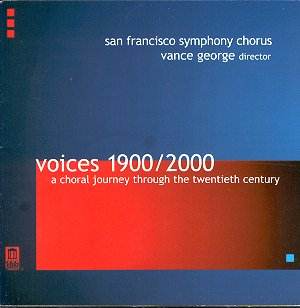 Voices: 1900-2000 – A Choral Journey Through The Twentieth Century
Voices: 1900-2000 – A Choral Journey Through The Twentieth Century
San Francisco Symphony Chorus, Vance George, Director
DELOS DE 3270 [62.26]
In Voices: 1900-2000, the San Francisco Symphony Chorus, under the capable direction of Vance George, offers a compelling auditory tapestry that traverses a century of choral innovation. This collection not only showcases the remarkable versatility of the choir but also encapsulates the dynamic evolution of choral music across various stylistic movements, including Romanticism, Impressionism, Expressionism, and Minimalism. Each selection, spanning from John Tavener’s ethereal Song for Athene to Leonard Bernstein’s exuberant Make Our Garden Grow, provides a window into the diverse expressive potentials of the human voice.
The programme’s structure is thoughtfully organized, particularly in its grouping of French works, which provides a coherent thematic experience. The warm, nuanced performances of Claude Debussy’s Dieu Qu’il La Fait Bon Regarder and Francis Poulenc’s Bois meutri exemplify the choir’s capacity for lyrical beauty, showcasing a blend of rich harmonies and delicate phrasing. The ensemble’s tonal clarity and blend are particularly effective here, with each voice contributing to the overall harmonic fabric without overshadowing the others—a testament to Mr. George’s careful preparation and the choir’s commendable discipline.
Randall Thompson’s Alleluia emerges as a highlight, embodying ecstatic joy through its soaring lines and rhythmic vitality. The choir’s ability to navigate the piece’s crescendos and decrescendos with precision and emotional depth is noteworthy; they imbue the work with both fervor and restraint, a balance that is essential in Thompson’s choral writing. This performance rivals other notable recordings, such as the Boston Symphony Orchestra Chorus’s interpretation under the late conductor Seiji Ozawa, which similarly captures the work’s spiritual essence.
Among the new discoveries on this recording, Conrad Susa’s Winds of May stands out with its buoyant choral lines and an intricate piano accompaniment, executed here with a delightful swing and finesse. Susa’s writing, marked by a deft interplay between voices and piano, thrives in this performance, leaving a lasting impression of vitality and charm.
However, not all selections resonate with equal impact. Meredith Monk’s presence in this collection, though significant, raises questions regarding the breadth of representation. Her Earth Seen From Above, which is notably the longest piece, tends to meander without a strong thematic focus, leading to moments of disengagement. This is juxtaposed sharply with the more structured and compelling works from figures like John Adams, whose choral pieces—rich in dramatic substance—could have provided a more substantial alternative.
The inclusion of Jerome Kern’s All the Things You Are is puzzling, particularly as the arrangement omits the introductory verse, reducing the piece to a truncated refrain. The artistic choices in this arrangement detract from Kern’s original melodic brilliance, a missed opportunity considering the richness of the song’s harmonic language. This fussy approach risks obscuring the inherent beauty of the tune, which deserves a more faithful and unadorned interpretation.
Recording quality and engineering are commendable, capturing the choir’s expansive sound without sacrificing clarity. The balance between voices and piano is expertly managed, allowing the intricate textures of the choral arrangements to shine through. Full texts are provided, enhancing the listener’s engagement with the program.
In conclusion, Voices: 1900-2000 stands as an impressive testament to the choral repertoire of the twentieth century, showcasing the San Francisco Symphony Chorus’s exceptional talent and versatility. While certain selections may not achieve the heights of others, the overall standard of performance remains high, affirming Vance George’s tenure as a director who fosters both musicality and technical precision. This recording not only celebrates a century of choral music but also invites listeners to reflect on the ongoing evolution and expression of the choral art form.



